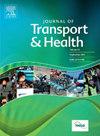Multivariate analysis of frequency, duration and companionship in walking behaviors among adults over 50
IF 3.3
3区 工程技术
Q2 PUBLIC, ENVIRONMENTAL & OCCUPATIONAL HEALTH
引用次数: 0
Abstract
Introduction
Physical activity is essential for maintaining mental and physical health. Despite its benefits, older adults fall short of the recommended physical activity levels. Walking, in particular, offers significant advantages for older adults because of its low-impact nature and lower likelihood of serious injuries. This paper examines three key dimensions of walking behavior among adults aged 50 and older: frequency, duration, and social companionship (SC).
Methods
Utilizing data from the 2022 American Association of Retired Persons (AARP) Walking Survey, and employing a joint modeling approach, we identify the factors influencing each of the three dimensions of walking behavior.
Results
Our findings suggest that older unemployed adults from low-income/minority households, women, and individuals in households with children tend to walk less frequently and for shorter durations. Having social company on walks has the highest positive effect on both walking frequency and duration, dominating over other sociodemographic factors. The results also point to specific population segments: specifically Black individuals, those employed, and single adults, walk less in groups, while those in households with children walk more in groups.
Conclusions
The findings highlight the importance of considering social aspects in understanding walking behavior, and call for policies that foster group walking programs, enhance safe and age-friendly walking environments, and implement customized awareness/incentive initiatives to increase physical activity and provide equitable access to the many health benefits of walking.
50岁以上成年人步行行为的频率、持续时间和陪伴的多变量分析
体育活动对保持身心健康是必不可少的。尽管它的好处,老年人没有达到建议的身体活动水平。特别是步行,因为其低冲击的性质和较低的严重伤害的可能性,为老年人提供了显著的优势。本文研究了50岁及以上成年人步行行为的三个关键维度:频率、持续时间和社会陪伴(SC)。方法利用2022年美国退休人员协会(AARP)步行调查数据,采用联合建模方法,确定影响步行行为三个维度的因素。结果我们的研究结果表明,来自低收入/少数民族家庭的失业老年人、妇女和有孩子的家庭的个人往往走路频率更低,持续时间更短。散步时有同伴陪伴对步行频率和持续时间都有最大的积极影响,这比其他社会人口统计学因素更重要。研究结果还指向了特定的人群:特别是黑人、有工作的人和单身成年人,他们结伴行走的次数较少,而有孩子的家庭则更多地结伴行走。结论:研究结果强调了在理解步行行为时考虑社会因素的重要性,并呼吁制定政策,促进团体步行计划,加强安全和老年人友好的步行环境,实施定制的意识/激励举措,以增加身体活动,并提供公平获得步行的许多健康益处。
本文章由计算机程序翻译,如有差异,请以英文原文为准。
求助全文
约1分钟内获得全文
求助全文

 求助内容:
求助内容: 应助结果提醒方式:
应助结果提醒方式:


